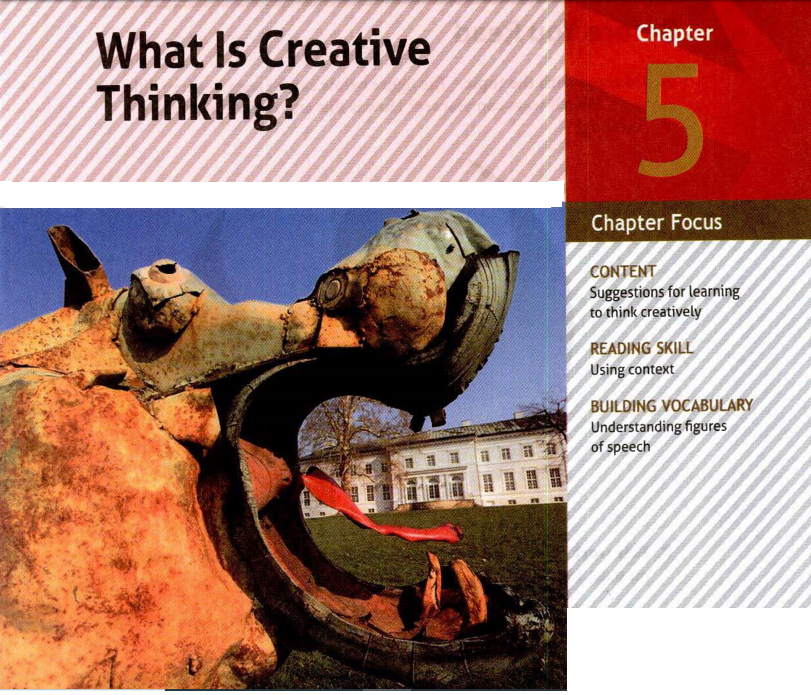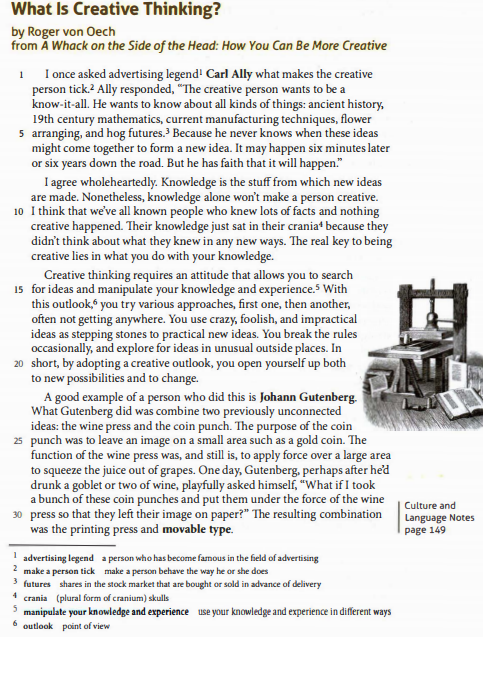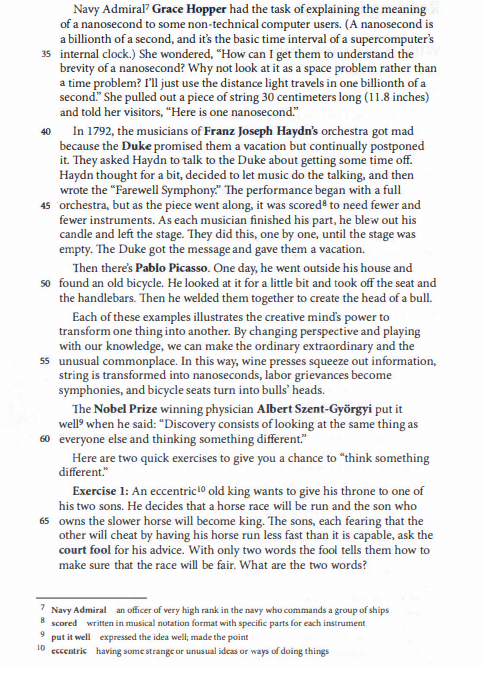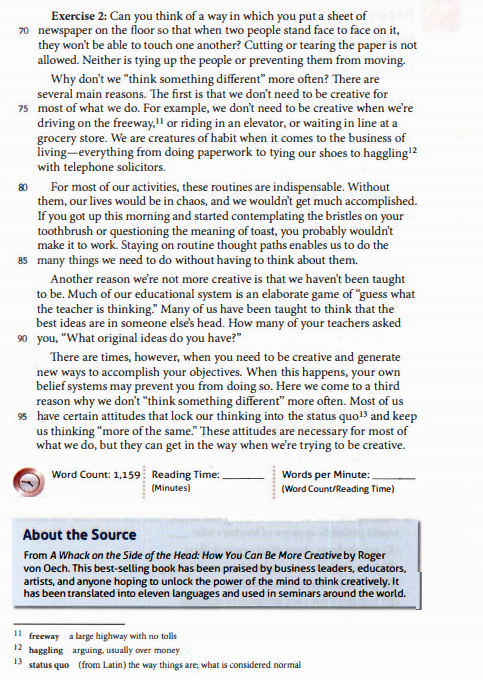
What Is Creative Thinking?
by Roger von Oech
from A Whack on the Side of the Head: How You Can Be More Creative
تفکر خلاق چیست؟
از راجر فون اوچ
از ضربه ای بر کنار سر: چگونه می توانید خلاق تر باشید



I once asked advertising legend۱ Carl Ally what makes the creative person tick.Ally responded, "The creative person wants to be a know-it-all. He wants to know about all kinds of things: ancient history, ۱۹th century mathematics, current manufacturing techniques, flowers arranging, and hog futures. Because he never knows when these ideas might come together to form a new idea. It may happen six minutes later or six years down the road. But he has faith that it will happen:
من یکبار از کارل الی که در تبلیغات معروف است، پرسیدم چه چیزی باعث می شود یک شخص خلاق، به شیوه خاص رفتار کند. الی پاسخ داد، شخص خلاق می خواهد که علامه دهر(فردی همه چیز دان) باشد. او می خواهد در مورد همه چیز بداند: تاریخ باستان، ریاضیات قرن ۱۹، گل آرائی و قراردادهای برای تحویل لاشه گراز در آینده. زیرا او هرگز نمی داند چه زمانی ممکن است این ایده ها د ر کنار هم جمع شوند تا ایده جدیدی شکل دهند. ممکن است شش دقیقه بعد یا شش سال بعد در آینده اتفاق بیفتد. اما او ایمان دارد این اتفاق خواهد افتاد.
I agree wholeheartedly. Knowledge is the stuff from which new ideas are made. Nonetheless, knowledge alone won't make a person creative. I think that we've all known people who knew lots of facts and nothing creative happened. Their knowledge just sat in their crania because they didn't think about what they knew in any new ways. The real key to being creative lies in what you do with your knowledge.
من از صمیم قلب موافقم. دانش چیزهایی است که ایده های جدید از آن ساخته می شوند. با این وجود، دانش به تنهایی باعث خلاقیت فرد نمی شود. من فکر می کنم همه ما افرادی را می شناسیم که واقعیت های زیادی را می دانند و هیچ چیز خلاقانه ای رخ نداده است. دانش آنها فقط در جمجمه هایشان نشسته است. زیرا آنها به هیچ وجه به آنچه می دانستند به روش های جدید، فکر نمی کردند. کلید اصلی خلاق بودن در این است که شما با دانش خود چیکار می کنید.
Creative thinking requires an attitude that allows you to search for ideas and manipulate your knowledge and experience. With this outlook, you try various approaches, first one, then another, often not getting anywhere. You use crazy, foolish, and impractical ideas as stepping stones to practical new ideas. You break the rules occasionally, and explore for ideas in unusual outside places. In short, by adopting a creative outlook, you open yourself up both to new possibilities and to change
تفکر خلاق به نگرشی نیاز دارد که به شما امکان می دهد ایده ها را جستجو کنید و دانش و تجربه خود را به کار ببرید. با این دیدگاه، شما رویکردهای مختلفی را امتحان می کنید، اول یکی، سپس دیگری، غالباً به جایی نمی رسید. شما از ایده های ابلهانه، احمقانه و غیر عملی به عنوان پله های پیشرفت به سمت ایده های عملی جدید استفاده می کنید. شما قوانین را گاهاً می شکنید و در مکانهای بیرونی و غیر معمول به جستجوی ایده می پردازید. به طور خلاصه، با اتخاذ یک دیدگاه خلاق، خود را پذیرای امکانات و تغییر جدید می کنید.
A good example of a person who did this is Johann Gutenberg. What Gutenberg did was combine two previously unconnected ideas: the wine press and the coin punch. The purpose of the coin punch was to leave an image on a small area such as a gold coin. The function of the wine press was, and still is, to apply force over a large area to squeeze the juice out of grapes. One day, Gutenberg, perhaps after he'd drunk a goblet or two of wine, playfully asked himself, "What if I took a bunch of these coin punches and put them under the force of the wine press so that they left their image on paper?" The resulting combination was the printing press and movable type.
مثال خوبی از شخصی که این کار را کرد، یوهان گوتنبرگ است. کاری که گوتنبرگ انجام داد این بود که دو ایده غیرمرتبط قبلی را با هم ترکیب کرد: دستگاه انگور له کنی و پانچ سکه. هدف از پانچ سکه این بود که تصویری را در یک منطقه کوچک مانند یک سکه طلا حک کنند. عملکرد دستگاه انگور له کن، اعمال نیرو بر روی یک منطقه بزرگ برای فشردن آب از انگور بود که هنوز هم است. یک روز ، گوتنبرگ ، شاید پس از نوشیدن یک، دو لیوان شراب، با خوشحالی از خود پرسید: "اگر یک دسته از این پانچ های سکه را بردارم و آنها را زیر فشار دستگاه انگور له کنی قرار دهم، آنها تصویر خود را روی کاغذ باقی می گذارند؟ نتیجه ترکیب، دستگاه چاپ فشاری و چاپ متحرک بود.
Navy Admiral Grace Hopper had the task of explaining the meaning of a nanosecond to some non-technical computer users. (A nanosecond is a billionth of a second, and it's the basic time interval of a supercomputer's internal clock.) She wondered, "How can I get them to understand the brevity of a nanosecond? Why not look at it as a space problem rather than a time problem? I'll just use the distance light travels in one billionth of asecond." She pulled out a piece of string ۳۰ centimeters long ( ۱۱.۸ inches) and told her visitors, "Here is one nanosecond
دریاسالار گریس هاپر وظیفه داشت تا معنی نانوسکند را برای تعدادی از کاربران غیرفنی کامپیوتر توضیح دهد. ( یک نانوسکند یک میلیاردم ثانیه است و این فاصله زمانی اصلی ساعت داخلی یک ابر کامپیوتر است.) وی با کنجکاوی از خود پرسید؛ چگونه می توانم نانوسکند را بصورت خلاصه به آنها بفهمانم؟ چرا به عنوان یک مسئله فاصله بجای یک مسئله زمانی به آن نگاه نکنیم؟ من فقط مسافتی را که نور در یک میلیاردم ثانیه طی می کند، بکار می برم. او یک تکه نخ به طول سی سانتیمتر در آورد و به بازدیدکنندگان گفت این یک میلیاردم ثانیه است.
In ۱۷۹۲, the musicians of Franz Joseph Haydn's orchestra got mad because the Duke promised them a vacation but continually postponed it. They asked Haydn to talk to the Duke about getting some time off. Haydn thought for a bit, decided to let music do the talking, and then wrote the "Farewell Symphony:' The performance began with a full orchestra, but as the piece went along, it was scored۸ to need fewer and fewer instruments. As each musician finished his part, he blew out his candle and left the stage. They did this, one by one, until the stage was empty. The Duke got the message and gave them a vacation.
در سال ۱۷۹۲ ، نوازندگان ارکستر فرانسز جوزف هایدن عصبانی شدند زیرا دوک به آنها وعده تعطیلات می داد اما به طور مداوم آن را به تعویق می انداخت. آنها از هایدن خواستند که در مورد مرخصی با دوک صحبت کند. هایدن کمی فکر کرد و تصمیم گرفت، که اجازه دهد موسیقی صحبت کند و سپس "سمفونی وداع" را نوشت: "این اجرا با یک ارکستر کامل آغاز شد، اما نت ها برای هر وسیله طوری نوشته شده بود که با پیش رفتن هر قطعه؛ نیاز به ابزارهای کمتر و کمتری برای نواختن بود. هر نوازنده که قسمت خود را تمام می کرد، شمع خود را خاموش کرده و صحنه را ترک می کرد. آنها این کار را یکی یکی انجام دادند تا صحنه خالی شد.
Then there's Pablo Picasso. One day, he went outside his house and so found an old bicycle. He looked at it for a little bit and took off the seat and the handlebars. Then he welded them together to create the head of a bull. Each of these examples illustrates the creative mind's power to transform one thing into another. By changing perspective and playing with our knowledge, we can make the ordinary extraordinary and the unusual commonplace. In this way, wine presses squeeze out information, string is transformed into nanoseconds, labor grievances become symphonies, and bicycle seats turn into bulls' heads.
بعدی پابلو پیکاسو است. یک روز، او به بیرون خانه خود رفت و یک دوچرخه قدیمی پیدا کرد. کمی به آن نگاه کرد و صندلی و فرمان دوچرخه را جدا کرد. سپس او آنها را به هم جوش داد تا سر یک گاو ایجاد شود. هر یک از این مثالها قدرت ذهن خلاق را برای تبدیل یک چیز به چیز دیگر نشان می دهد. با تغییر دیدگاه و بازی با دانش خود، می توانیم امری عادی را، خارق العاده و غیر معمول بسازیم. به این ترتیب، با فشار دادن دستگاه انگور له کنی؛ اطلاعات بیرون می آید، نخ به نانو ثانیه ها تبدیل می شود، شکایات کارگری به سمفونی تبدیل می شوند و صندلی های دوچرخه به سر گاو نر تبدیل می شوند.
The Nobel Prize winning physician Albert Szent-Gyorgyi put it well when he said: "Discovery consists of looking at the same thing as everyone else and thinking something different:'Here are two quick exercises to give you a chance to "think something different:
آلبرت سزنت - جورجی، این مطلب را به خوبی بیان کرد، زمانیکه گفت: کشف شامل نگاه کردن به چیزها همانند دیگران ولی تفکر کردن بصورتی متفاوت است. در اینجا دو تمرین سریع وجود دارد تا به شما فرصت دهد در مورد چیزی متفاوت فکر کنید:
his two sons. He decides that a horse race will be run and the son who owns the slower horse will become king. The sons, each fearing that the other will cheat by having his horse run less fast than it is capable, ask the court fool for his advice. With only two words the fool tells them how to make sure that the race will be fair. What are the two words?
تمرین ۱: یک پادشاه پیر عجیب و غریب می خواست تاج و تخت خود را به یکی از دو پسرش بدهد. او تصمیم گرفت که مسابقه اسب سواری انجام شود و هر پسر که اسب او آهسته تر برود برنده باشد. پسرها هر کدام می ترسیدند دیگری تقلب کند و اسب را کمتر از آنچه قادر است، براند. از تلخک دربار درخواست مشورت کردند. با دو لغت تلخک به آنها می گوید چطور مطمئن شوند که مسابقه عادلانه است. آن دو لغت چه هستند؟
Exercise ۲: Can you think of a way in which you put a sheet of newspaper on the floor so that when two people stand face to face on it, they won't be able to touch one another? Cutting or tearing the paper is not allowed. Neither is tying up the people or preventing them from moving.
تمرین ۲: آیا می توانید به روشی فکر کنید که بتوانید یک روزنامه را طوری روی زمین بگذارید که وقتی دو نفر به صورت رو به روی هم روی آن می ایستند، دیگر قادر به لمس یکدیگر نباشند؟ برش یا پاره شدن کاغذ مجاز نیست. نه افراد را ببندید و نه مانع حرکت کردن آنها شوید.
Why don't we "think something different" more often? There are several main reasons. The first is that we don't need to be creative for most of what we do. For example, we don't need to be creative when we're driving on the freeway, ۱۱ or riding in an elevator, or waiting in line at a grocery store. We are creatures of habit when it comes to the business of living-everything from doing paperwork to tying our shoes to haggling with telephone solicitors
چرا ما اغلب "چیزی متفاوت فکر نمی کنیم"؟ چندین دلیل اصلی وجود دارد. نکته اول این است که ما برای بیشتر کارهایی که انجام می دهیم نیازی به خلاقیت نداریم. به عنوان مثال، هنگام رانندگی در آزاد راه، سوار شدن در آسانسور یا انتظار در صف فروشگاه های مواد غذایی، لازم نیست که خلاق باشیم. وقتی صحبت از کار و بار زندگی می شود، ما موجودات عادتیم - هر چیز ی از انجام کارهای کاغذی گرفته تا گره زدن کفش هایمان و چانه زدن با وکلای بوسیله تلفن.
For most of our activities, these routines are indispensable. Without them, our lives would be in chaos, and we wouldn't get much accomplished. If you got up this morning and started contemplating the bristles on your toothbrush or questioning the meaning of toast, you probably wouldn't make it to work Staying on routine thought paths enables us to do the many things we need to do without having to think about them
برای بیشتر فعالیتهای ما، این روال ها ضروری است. بدون آنها، زندگی ما هرج و مرج خواهد شد و خیلی به موفقیت دست پیدا نمی کنیم. اگر امروز صبح از خواب برخاستید و شروع به تفکر در مورد موهای مسواک کردید یا در مورد معنای نان تست سوال کردید؛ احتمالاً نخواهید توانست طبق روال عادی با آنها کار کنید. مسیرهای فکری ما را قادر می سازد تا چیزهای زیادی را انجام دهیم، بدون آنکه در مورد آنها فکر کنیم.
Another reason we're not more creative is that we haven't been taught to be. Much of our educational system is an elaborate game of guess what the teacher is thinking:' Many of us have been taught to think that the best ideas are in someone else's head. How many of your teachers asked you, "What original ideas do you have?"
دلیل دیگری که ما بیشتر خلاق نیستیم این است که به ما آموزش داده نشده است. بخش اعظم سیستم آموزشی ما یک بازی پیچیده برای حدس زدن آنچه معلم فکر می کند است: خیلی از ما یاد گرفته ایم که بهترین ایده ها در سر دیگران است. چند تا از معلم های شما از شما پرسیده اند چه ایده های اصلی دارید؟
There are times, however, when you need to be creative and generate new ways to accomplish your objectives. When this happens, your own belief systems may prevent you from doing so. Here we come to a third reason why we don't think something different more often. Most us have certain attitudes that lock our thinking into the status quo and keep us thinking more of the same:' These attitudes are necessary for most of what we do, but they can get in the way when we're trying to be creative
با این وجود مواقعی وجود دارد که شما نیاز به خلاق بودن و ایجاد روشهای جدید برای تحقق اهداف خود دارید. هنگامی که این اتفاق می افتد ، سیستم های باوری شما ممکن است مانع از انجام این کار شوند. در اینجا به دلیل سومی می رسیم که چرا بیشتر اوقات در مورد چیزی متفاوت فکر نمی کنیم. اکثر ما نگرش خاصی داریم که تفکر ما را به وضع موجود می بندد و باعث می شود که یکنواخت فکر کنیم. این گرایش برای بیشتر کارهایی که انجام می دهیم ضروری است اما وقتی تلاش می کنیم خلاق باشیم، آنها می توانند مانع ما شوند.

